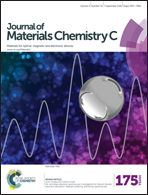A two-dimensional cobalt(ii) network with a remarkable positive axial anisotropy parameter exhibiting field-induced single-ion magnet behavior†
Abstract
Based on the 1H-3-(3-pyridyl)-5-(3′-pyridyl)-1,2,4-triazole (3,3′-Hbpt) ligand, {[Co(3,3′-Hbpt)2(SCN)2]·2H2O}n (1) and {[Ni(3,3′-Hbpt)2(SCN)2]·2H2O}n (2) have been prepared and structurally determined by single-crystal X-ray crystallography. The Co(II)/Ni(II) ions are bridged by the curved 3,3′-Hbpt ligands to generate helix chains, further forming a two-dimensional (2D) sheet in which Co(II)/Ni(II) ions are spatially separated from each other by a long spacer 3,3′-Hbpt ligand. Alternating-current magnetic susceptibility measurements show that the individual octahedral Co(II) ions in 1 exhibit field-induced slow magnetic relaxation, dominated by a Raman-like process. Compound 1 exhibits a very large positive axial anisotropy parameter (D = +70.1 cm−1) and a small transverse anisotropy parameter (|E| = 0.7 cm−1) by analysis of direct current magnetic data, which are further confirmed by high-field electron paramagnetic resonance (HF-EPR) spectroscopy and ab initio calculations. Furthermore, the semiconducting behaviors of 1 and 2 were also studied, which could be used as wide-gap semiconductors.


 Please wait while we load your content...
Please wait while we load your content...